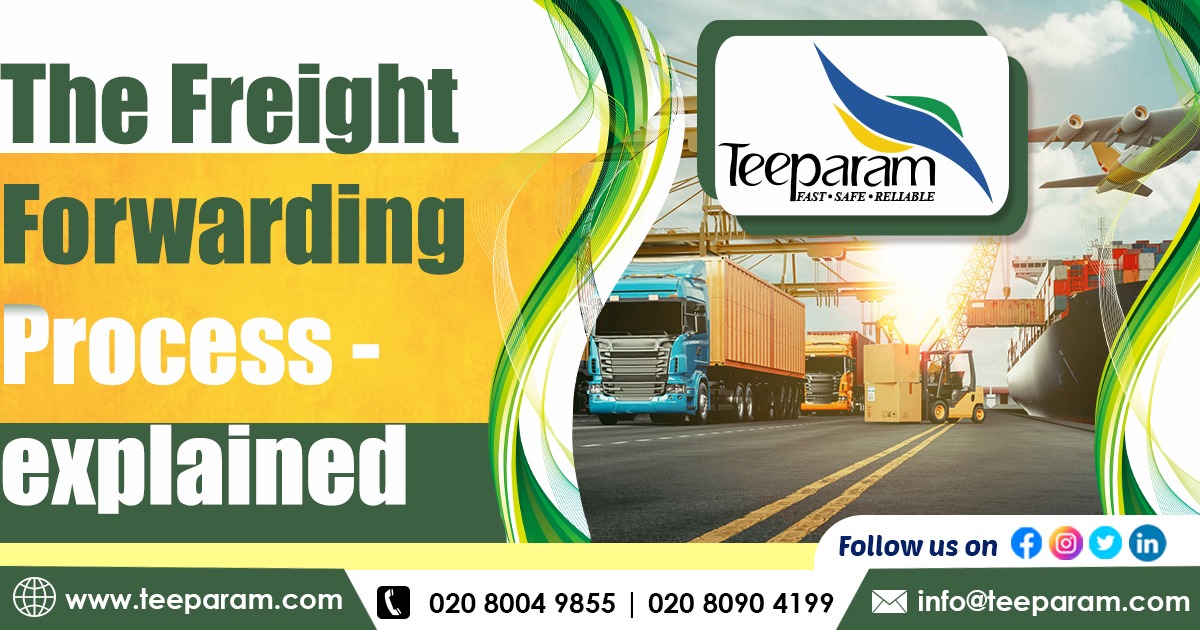
The Freight Forwarding Process – Explained
Have you ever wondered how that shiny new gadget from halfway across the world ends up on your doorstep? Or how businesses keep their supply chains humming without getting bogged down in a mess of paperwork and shipping woes? That’s where freight forwarding comes in. It’s like the unsung hero of global trade, the behind-the-scenes wizard that makes sure goods move from point A to point B smoothly and efficiently. In this article, I’ll break down the freight forwarding process step by step, drawing from real-world examples and insights I’ve gathered over the years. We’ll aim to keep it straightforward, no jargon overload, but detailed enough to give you a solid grasp. By the end, you’ll see why freight forwarders are indispensable in today’s interconnected economy.
So, what’s freight forwarding?
Picture a logistics maestro who doesn’t own ships, planes, or lorries but orchestrates their use to move goods efficiently. Freight forwarders are the middlemen – or rather, the experts – who handle the complexities of shipping for UK importers and exporters. They deal with carriers, customs, and paperwork, so you don’t have to. With the UK’s trade heavily tied to global markets (think £650 billion in exports annually, per 2024 stats), freight forwarders are critical. Post-Brexit, their role has only grown as businesses navigate new EU trade rules. Whether it’s getting Scottish whisky to Japan or importing car parts to Birmingham, forwarders make it happen.
Why use one?
International shipping is a minefield of customs forms, tariffs, and transport logistics. A good forwarder saves time, cuts costs, and prevents headaches. For example, during the 2021 HGV driver shortage in the UK, forwarders found workarounds like rail freight to keep goods moving. Without them, shelves would’ve been emptier than a pub at closing time.
Let’s break down the process. It’s not one-size-fits-all – it depends on what you’re shipping, where to, and how fast you need it. But here’s the typical flow, with a UK lens and some tips to avoid pitfalls.
S tep 1: Consultation and Quotation
It all starts with a conversation. You, the shipper (maybe a Leeds manufacturer or a London retailer), contact a freight forwarder with the details: What’s the cargo? How much? Where’s it going? Any special needs, like refrigeration for Cornish cheese or hazardous goods compliance for chemicals?
The forwarder maps out the best route and transport mode. Air freight is quick but costly – great for high-value items like tech gadgets. Sea freight, via ports like Felixstowe, is cheaper for bulk goods like furniture but takes weeks. For EU shipments, road freight via the Channel Tunnel is common, though Brexit checks can slow things down. They might propose multimodal transport, mixing lorry, ship, and rail for cost-efficiency.
Then comes the quote, covering transport, customs duties, insurance, and fees. A tip: Always compare quotes from multiple forwarders. Watch for hidden costs like “port congestion charges,” which spiked during the 2021 supply chain crunch. A sharp forwarder will build in buffers for delays, especially at busy ports like Dover.
Once you agree, you sign a contract, often a bill of lading (B/L) for sea or an air waybill for flights. This acts as a receipt and proof of ownership.
Step 2: Booking and Documentation
With the deal set, the forwarder books space with carriers – no small feat during peak times like Christmas, when ships and planes are packed. They secure container space at Southampton or a cargo hold at Heathrow.
Now, the paperwork. It’s the bane of shipping but vital. Key documents include:
- Commercial Invoice: Shows the transaction value for customs.
- Packing List: Details what’s in the shipment.
- Certificate of Origin: Proves where goods were made, critical for UK-EU trade post-Brexit to determine tariffs.
- Export/Import Declarations: Required for customs compliance.
For UK exporters, the forwarder files through HMRC’s Customs Handling of Import and Export Freight (CHIEF) system or its successor, the Customs Declaration Service (CDS). Errors here can lead to delays or fines. Take the 2021 case of a UK clothing brand whose EU shipments were held up over incorrect EORI numbers (Economic Operators Registration and Identification). Forwarders prevent such cock-ups.
They also arrange cargo insurance, covering loss or damage – a must, given the North Sea’s stormy moods.
Step 3: Pickup and Origin Handling
The forwarder arranges pickup from your location – say, a warehouse in Birmingham or a farm in Norfolk. This might involve a lorry to a port like Liverpool or an airport like Gatwick.
At the port, cargo is processed. For less-than-container-load (LCL) shipments, your goods share container space to save costs. Full-container-load (FCL) shipments are sealed and loaded directly. For air freight, security checks under the UK’s Known Consignor scheme ensure compliance to avoid delays.
Step 4: Transportation
Now the goods hit the road, sea, or sky:
- Sea Freight: Containers sail from ports like Felixstowe, the UK’s busiest. Asia to the UK takes 4-6 weeks. Forwarders track via GPS and update ETAs.
- Air Freight: Faster, often 1-5 days, ideal for urgent items like medical supplies. Heathrow handles much of this.
- Road Freight: Common for EU deliveries via Eurotunnel or ferries. Post-Brexit, expect extra checks at Calais.
Forwarders monitor for hiccups – storms, strikes, or port backlogs. Remember the 2021 Dover chaos when Brexit rules caused lorry queues stretching for miles? Forwarders rerouted via alternative ports like Harwich.
Step 5: Customs Clearance
Customs is where many shipments stumble. At the destination, the forwarder acts as your customs broker, submitting paperwork and paying duties. In the UK, they navigate HMRC’s rules; for EU destinations, they tackle post-Brexit requirements like the EU’s Import Control System (ICS2).
Correct classification of goods (using HS codes) is key to avoiding high tariffs. Inspections may happen, especially for food or restricted items. Once cleared, the cargo is released.
Step 6: Delivery and Final Handling
The last leg – or “final mile” – involves transport from port to destination, like a shop in Cardiff or a warehouse in Glasgow. The forwarder handles drayage (port-to-door transport), unloading, and, for LCL, deconsolidation.
Proof of delivery is issued, and you’re done. Forwarders may also manage claims if goods arrive damaged – a lifesaver if a container takes a tumble.
Challenges for UK Shippers
Freight forwarding isn’t all smooth sailing. Key issues include:
- Brexit Complexity: New customs rules mean more paperwork. Forwarders help with EORI registration and Rules of Origin compliance.
- Port Congestion: Dover and Felixstowe often face delays. Experienced forwarders use smaller ports like Immingham as backups.
- Driver Shortages: The UK’s HGV crisis lingers, pushing up road freight costs.
- Sustainability: With the UK aiming for net-zero, forwarders offer greener options like rail or low-emission ships.
Pick a forwarder with UK expertise and tech tools like real-time tracking to stay ahead.
Technology’s Role
Tech is transforming forwarding. Platforms like Freightos let UK businesses compare quotes online. IoT sensors monitor cargo conditions – vital for perishable exports like Scottish salmon. Blockchain ensures transparent documentation, reducing fraud.
Still, the human touch matters. A forwarder who knows UK ports and EU regulations can save the day when a shipment hits a snag.
Why It Matters to the UK
From small Etsy sellers in Bristol to giants like Rolls-Royce, freight forwarding keeps the UK connected. With exports to the EU alone worth £340 billion in 2024, and e-commerce booming, forwarders are busier than ever.
Looking ahead, as global trade grows and sustainability pressures mount, forwarders who embrace tech and green solutions will lead the pack. For UK businesses, a reliable forwarder is like a good cuppa – essential to keep things moving.
In short, freight forwarding is a complex dance of logistics, paperwork, and problem-solving, but with the right partner, it’s a breeze. Whether you’re shipping Welsh wool or importing Spanish olives, a forwarder makes it happen.
Trusted Partner for Seamless Sea Freight from the UK
If you’re a UK business looking to ship goods to India or beyond, Teeparam Logistics is a standout choice for reliable sea freight services. Based on their offerings at Teeparam Sea Freight, they excel in simplifying the freight forwarding process with tailored solutions like Full Container Load (FCL), Less-than-Container Load (LCL), and Conventional Load for oversized cargo. Their focus on cost-effective, secure, and timely delivery, backed by real-time tracking and 24/7 support, makes them a trusted partner for navigating the complexities of international shipping. Whether you’re sending small consignments or heavy machinery, Teeparam’s customer-centric approach and global network ensure your cargo arrives safely and on schedule.


